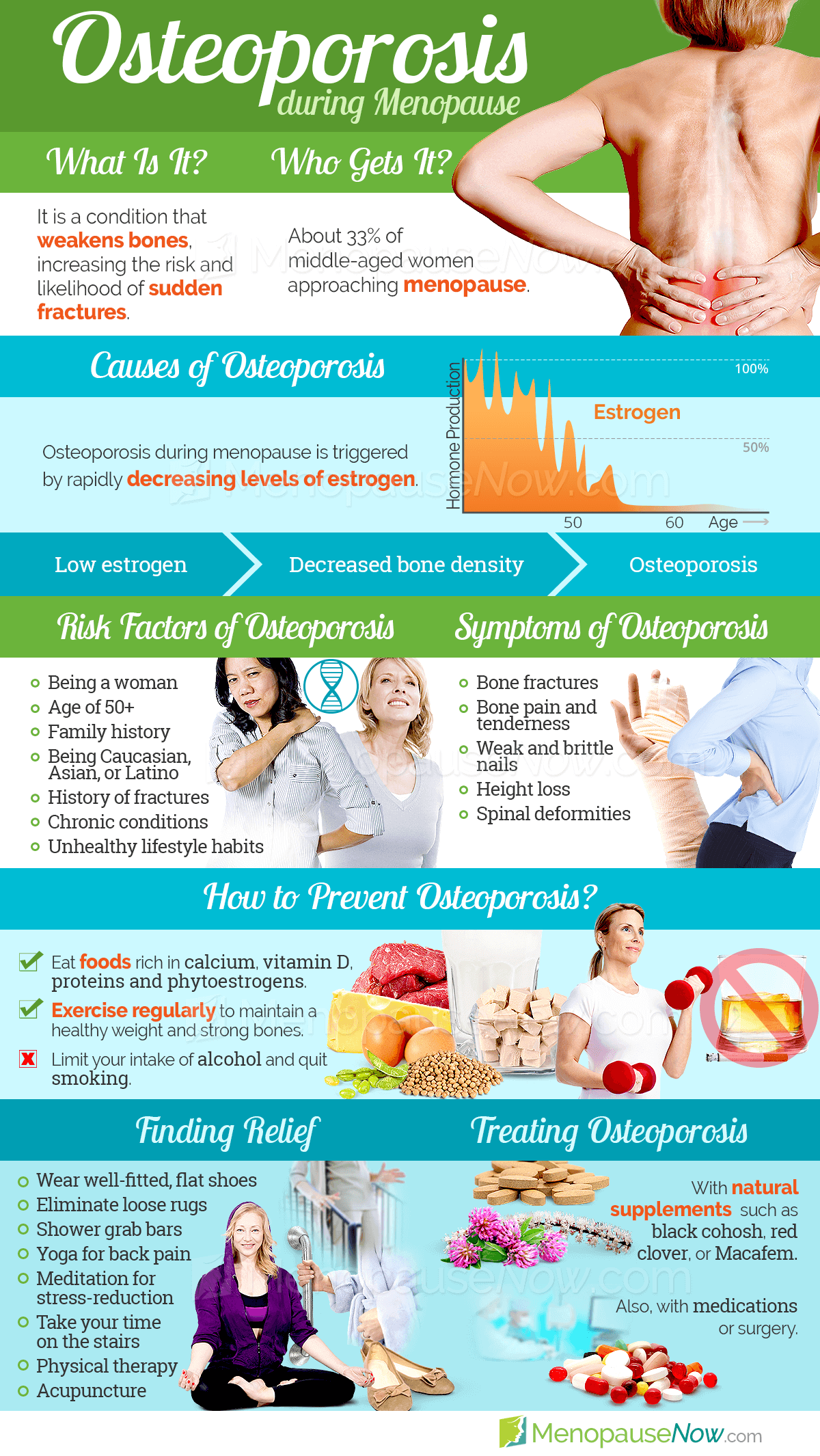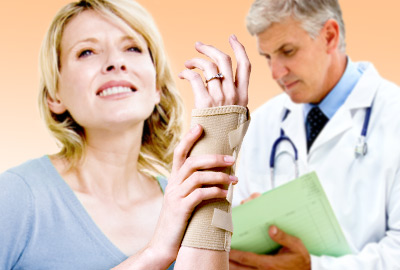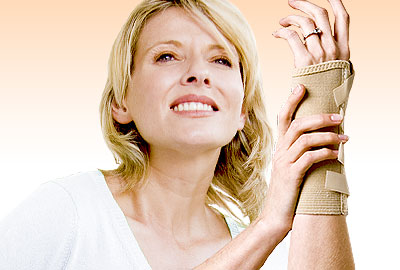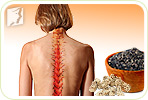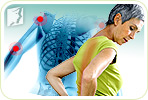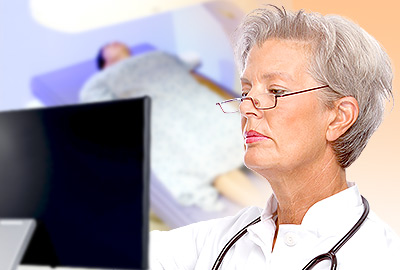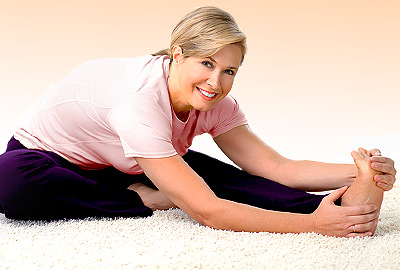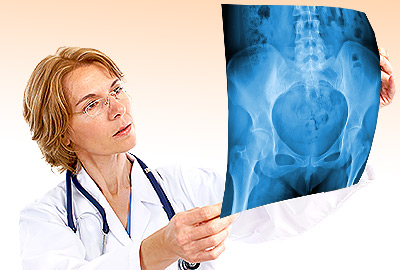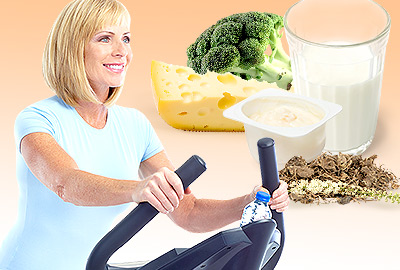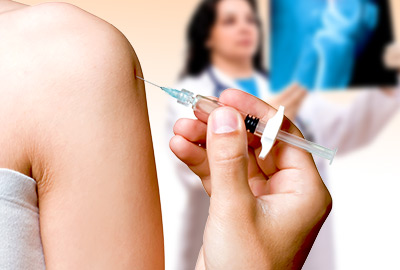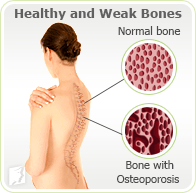
Osteoporosis is perhaps the most serious menopause symptom because it can lead to severe health problems, such as chronic back pain and broken bones. Not only does osteoporosis threaten a woman's physical health, but the disease can come on slowly and go unrecognized until a bone is fractured.
Approximately 33% of women over 50 will experience bone fractures as a result of osteoporosis.Hormonal fluctuations that precede menopause and the permanently low hormonal levels of postmenopause play a major role in the onset of osteoporosis.
There are treatment options available, but first it's important to better understand osteoporosis in order to know how to prevent and treat it. Continue reading below to learn about osteoporosis and its symptoms, risk factors associated with the disease, prevention tips, and treatment options.
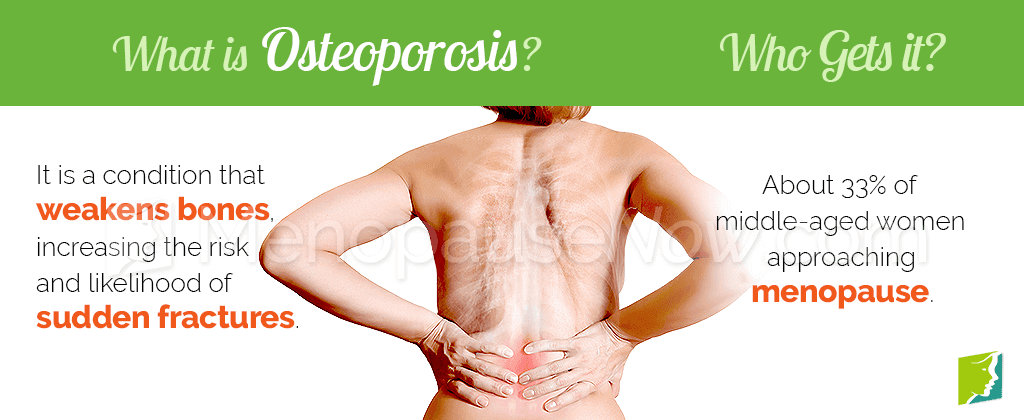
About Osteoporosis
Osteoporosis, which means "porous bone", is a disease that weakens bones and increases the risk of sudden and unexpected fractures. A hallmark of the disease is a significant decrease in bone mass and strength. It often progresses without any symptoms or pain. Generally, osteoporosis is not discovered until weakened bones cause painful fractures, usually in the back or hips.
An unfortunate aspect of the disease is that once an osteoporotic fracture occurs, there is a much higher risk of additional bone fractures. Another alarming statistic: up to 80% of osteoporosis sufferers are women. The disease does affect men, but at a drastically lower rate than women. This is because men generally have stronger, bulkier bones that do not lose their mass as easily. Men who do suffer from osteoporosis generally get it later in life than women.
Because women are more susceptible to developing osteoporosis, they have to take greater care to prevent or treat the disease. Continue reading below to learn what constitutes healthy bones, which will help on the road to treatment.
Calcium and healthy bones
The human body stores 99% of its calcium in the bones and teeth. Like every part of the body, the bones are continuously regenerating themselves, losing cells and creating new ones. As bones grow, they rely on calcium as structural material to build the proper bone density. Later in life, a loss in bone mass occurs, where the amount of cells lost outnumbers the amount of new cells generated. Calcium is necessary not only during the teenage years and young adulthood when bones grow the most, but also later in life to retain as much bone mass as possible. Below is information about recommended amounts of calcium intake per day and foods that are high in calcium.
Calcium Recommendations
- Children 1 - 3 years: 500 mg
- Children 4 - 8 years: 800 mg
- Youth 9 - 18 years: 1,300 mg
- Adults 19 - 50 years: 1,000 mg
- Adults 51+ years: 1,200 mg
Foods High in Calcium
- Most dairy products
- Soy and rice milk
- Chinese cabbage
- Dried figs
- Cooked greens
Symptoms of osteoporosis
One of the main issues with the onset of osteoporosis is that many people who begin developing it are unaware they are afflicted until they experience a bone fracture as a result. That is one reason it's important to take a proactive approach against osteoporosis. Symptoms generally begin to occur late in the disease when there are not many options to regain the necessary bone density. Below are the common symptoms that can indicate osteoporosis:
Common Symptoms of Osteoporosis
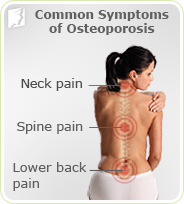
- Loss of height as a result of weakened spine
- Fractured bones, especially hip bones
- Bone pain and tenderness
- Neck, spine, and lower back pain
- Broken bones, brittle fingernails
- Periodontal disease, tooth loss
- Spinal deformities become evident, such as stooped posture, an outward curve at the top of the spine.
Click on the following link to learn more about osteoporosis, or continue reading to find out causes of osteoporosis.
Causes of Osteoporosis
Osteoporosis is inextricably linked to hormones. For this reason, women make up about 80% of osteoporosis sufferers, and a large percentage of those women have undergone menopause and the hormonal fluctuations associated with it. Estrogen is the predominant hormone that fades with the onset of menopause and puts women at a much higher risk of developing osteoporosis.
Estrogen and osteoporosis
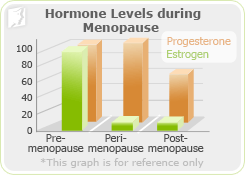
The graph to the right shows how drastically levels of estrogen drop off during menopause and postmenopause, beginning at about age 45. Estrogen levels in postmenopausal women are about one-tenth the amount present in premenopausal women. For this precise reason, women approaching menopause and those who have already gone through it are at a much higher risk of developing osteoporosis and suffering from bone fractures as a result.
Without adequate estrogen levels, bones are unable to absorb the proper amounts of calcium to replenish bone mass as cells slough off and die. The body also has trouble controlling the amount of bone cells that are destroyed without estrogen to regulate the function.
Did You Know?
Testosterone is the hormone responsible for bone strength and breakdown in men.
Estrogen's most important effect on osteoporosis appears to be prevention of bone breakdown, known as resorption. Healthy bones require a balance of osteoclasts (cells that breakdown bones) and osteoblasts (cells that make new bone). As estrogen levels diminish, osteoclasts live longer than their counterparts, osteoblasts. This leads to bones deteriorating at a faster rate than they can be rebuilt, causing them to grow weak and brittle.
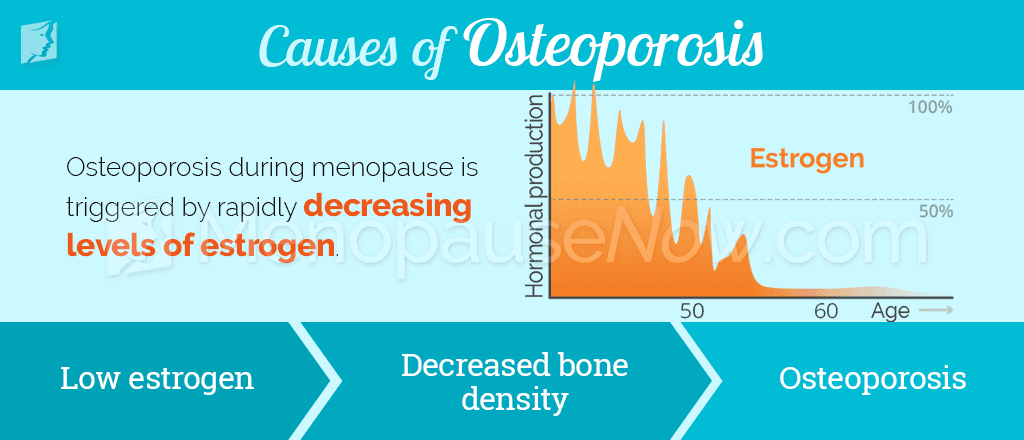
Other causes
The primary cause of osteoporosis in women as they surpass age 50 is diminished hormonal levels, particularly estrogen levels. However, there are other causes that need to be explored in order to have a comprehensive understanding of this serious bone disease. Other causes of osteoporosis include the following:
Medications. Some medications can reduce bones' ability to rebuild bone density. Some of the medications that can cause osteoporosis are glucocorticoid medications, prednisolone, excess thyroid hormone replacement, the blood thinner heparin, and certain anticonvulsant medications.
Insufficient bone growth as an adolescent. Bones that did not get enough calcium early in life have a higher likelihood of becoming osteoporotic and fracturing as estrogen levels begin to decrease.
- Genetic factors. If a woman's family members, especially her mother, have suffered from osteoporosis, the likelihood that she will develop the disease jumps dramatically. Genetics also helps determine the body type of a woman. If she inherited a small, thin body type, she is predisposed to osteoporosis.
Click on the following link to learn more about the causes of osteoporosis, or continue reading below for some risk factors of osteoporosis.
Risk Factors for Osteoporosis
Some people are more susceptible to osteoporosis than others. Some of the risk factors for osteoporosis are in the control of the individual, such as weight, while other risk factors cannot be controlled, such as a family history of osteoporosis.
Uncontrollable risk factors of osteoporosis
Age
Osteoporosis becomes far more common as people age, especially once they surpass age 50.
Sex
Osteoporosis is more common in women than men. About four out of five osteoporosis sufferers are women. Women going through menopause or those who are postmenopausal are even more susceptible because of diminished levels of estrogen, which is necessary for regenerating bone.
Family history
Research suggests that genetics play a major role in osteoporosis. Those whose parents have osteoporosis have a greater chance of developing the disease.
Race and ethnicity
While osteoporosis affects all races and ethnicities, people who are Caucasian or of Asian or Latino descent are more likely to develop osteoporosis than those of African heritage.
History of broken bones
People who have broken one or more bones during their adult years are at greater risk for osteoporosis. In fact, they may already have low bone density or osteoporosis.
Diseases and conditions
The following are some diseases and conditions that put a person with one or more of them at greater risk of developing osteoporosis: premature menopause, blood and bone marrow disorders, eating disorders, gastrectomy, gastrointestinal bypass procedures, multiple sclerosis, post-polio syndrome, rheumatoid arthritis, severe liver disease, spinal cord injuries, and stroke.
Controllable risk factors of osteoporosis
Risk factors related to habits can be reduced with healthy lifestyle adjustments.
Did You Know?
In women over 45, osteoporosis accounts for more days spent in hospital than many other diseases, including diabetes, myocardial infarction, and breast cancer.
Inactive lifestyle. People who are bedridden, are inactive, or do not exercise are at higher risk of osteoporosis.
Smoking. Smoking is bad for bones in many ways. For example, smoking lowers the body's estrogen levels.
Alcohol abuse. Drinking heavily can reduce bone formation. In many cases, people who drink too much do not get enough calcium. Drinking may also affect the body's calcium supply.
In addition, drinking too much is bad for a person's overall health. Alcohol in small amounts; however, does not appear to harm bone health. This usually means no more than two drinks a day.
Osteoporosis diagnosis
One of the only ways to determine if a person has osteoporosis is with a test called a bone density scan. It measures the amount of minerals in bones. This scan requires large machinery and must be conducted in a hospital or doctor's office with the right equipment.
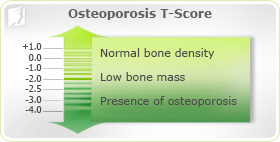
Bone density is measured on a point scale, called a "T-score." A T-score -1 or higher indicates normal bone density. If a person's T-score measures between -1 and -2.5, she will probably be diagnosed with osteopenia, a milder form of osteoporosis. A T-score of less than -2.5 indicates osteoporosis.
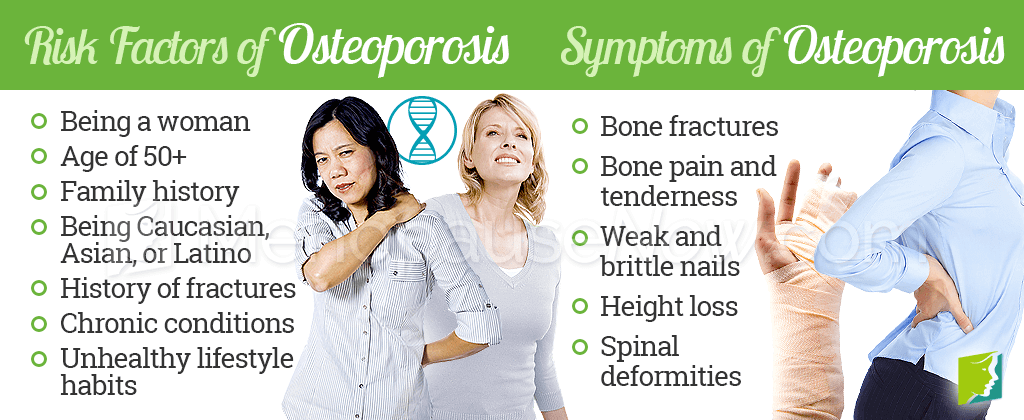
Click on the following link to learn more about osteoporosis risk factors, or read below to learn how to prevent osteoporosis.
Osteoporosis Prevention
The best way to avoid the painful and debilitating bone fractures that come with osteoporosis is to prevent the disease before it takes hold. While it is better to start these measures at a younger age, there are still ways to increase bone mass, or at least limit the rapid deterioration of bones common in menopausal women, before osteoporosis becomes a problem. Below is a list of prevention tips:
Statistics
A 10% loss of bone mass in the vertebrae can double the risk of vertebral fractures, and similarly, a 10% loss of bone mass in the hip can result in a two and a half times greater risk of hip fracture.
- Consume enough calcium
- Make sure to get enough vitamin D
- Get adequate physical exercise
- Avoid alcohol
- Avoid smoking
- Maintain a healthy weight
Preventing falls
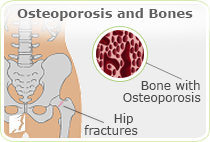
More than 90% of hip fractures are associated with osteoporosis. Nine out of ten hip fractures in older Americans are the result of a fall. Most falls happen to women in their homes in the afternoon.
The above data shows how important it is to take care to avoid falling, especially after a certain age when osteoporosis is more common, namely after age 50 in women. Below is a list of tips to prevent falls:
- Wear appropriate, flat shoes
- Wear glasses with the correct prescription and have this checked regularly
- Avoid having loose rugs and carpets or trailing electrical flexes; repair any torn floor coverings
- Make sure the home is well lit
- Be extra careful when taking medicines, especially sleeping pills and sedatives that may cause drowsiness, making a person more likely to trip or stumble
- Anyone who experiences dizziness or is at risk of falling should talk to their doctor about how their medications might affect this
- Anyone who needs to get up during the night to visit the toilet should consider using a chamber pot to avoid the risk of falling in the dark; otherwise, leave some lights on where possible and make sure the route from the bed to the toilet is safe and clear of items that could cause a fall
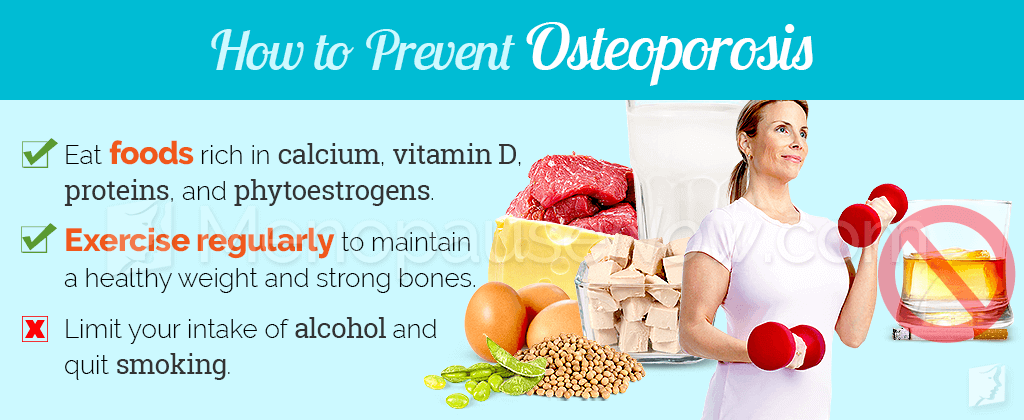
Click on the following link to learn more about osteoporosis prevention, or continue reading to get a comprehensive look at the treatment options available for osteoporosis.
Osteoporosis Treatments
When exploring treatments for osteoporosis, it's important to begin with methods that are the least obtrusive, with the least likelihood of side effects, and progress from there.
This means that lifestyle changes are the best place to begin. Simple lifestyle changes that can reduce the likelihood of osteoporosis include eating a diet rich in calcium and exercising to build bone strength.
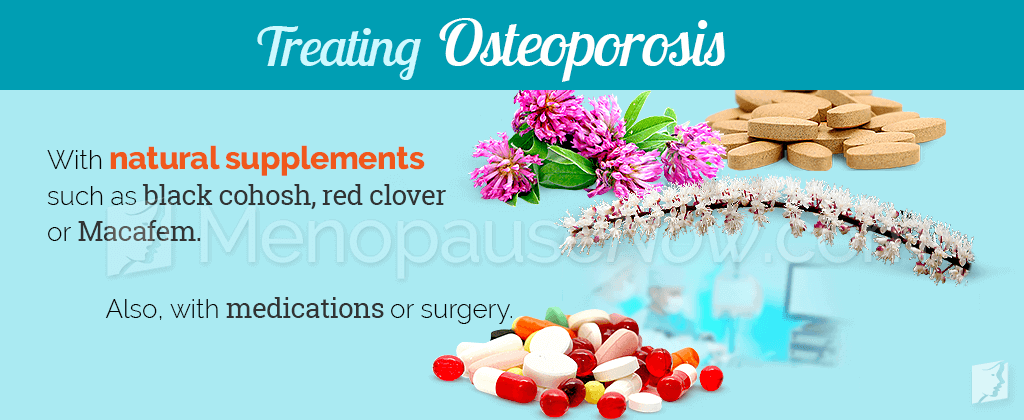
Did You Know?
Combining lifestyle changes and alternative medicines can help with mild osteoporosis. Alternative medicines can be different herbs and supplements, namely calcium supplements. When seeking out alternative medicines, keep in mind that osteoporosis during menopause is associated with hormonal imbalance, treatments that bring a natural balance to hormonal levels will go a long way in preventing osteoporosis at the core of the issue.
Finally, if osteoporosis is found to be extremely severe in a woman, there are different medications and surgeries that can be explored. Medications, including hormone replacement therapy (HRT), are often prescribed as a last resort because of the potential side effects and inherent risks.
Click on the following link to learn specific treatments for osteoporosis, which begin with lifestyle changes, move onto alternative medicines, and finally, if those options don't seem to help, medications and surgery. The most effective prevention methods for osteoporosis typically combine lifestyle changes and alternative medicines, though once the disease has set in, medications may be necessary.
Sources
- Christenson, E.S. et al. (2012). Osteoporosis management in post-menopausal women. Minerva Ginecologica, 64(3), 181-194. Retrieved from http://www.ncbi.nlm.nih.gov/pubmed/22635014
- Cleveland Clinic. (n.d.). Menopause and Osteoporosis. Retrieved May 10, 2016, from https://my.clevelandclinic.org/health/diseases_conditions/hic-what-is-perimenopause-menopause-postmenopause/hic_Menopause_and_Osteoporosis
- New York State Department of Health. (2015). Calcium and Healthy Bones. Retrieved May 10, 2016, from https://www.health.ny.gov/publications/1982.pdf
- Office on Women's Health. (2012). Osteoporosis fact sheet. Retrieved May 10, 2016, from http://www.womenshealth.gov/publications/our-publications/fact-sheet/osteoporosis.html
- University of Maryland Medical Center. (2015). Osteoporosis. Retrieved May 10, 2016, from http://umm.edu/health/medical/altmed/condition/osteoporosis
- U.S. Department of Health and Human Services. (n.d.). 18 Ways Smoking Affects Your Health. Retrieved May 10, 2016, from http://smokefree.gov/health-effects

